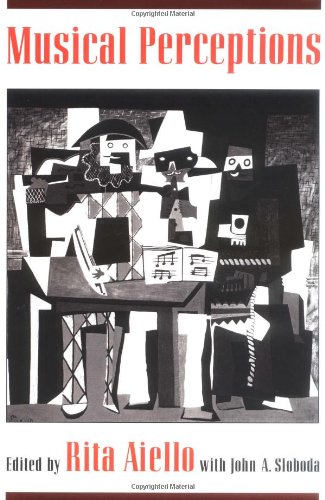 Musical Perceptions, Ed. Rita Aiello with John A. Sloboda. Oxford University Press, USA (1994). ISBN-13: 978-0195064766.
Musical Perceptions, Ed. Rita Aiello with John A. Sloboda. Oxford University Press, USA (1994). ISBN-13: 978-0195064766.
No musician can avoid thinking about how music is perceived; a few music researchers concern themselves with the subject as such. Musical Perceptions , a new collection of essays edited by Rita Aiello, with John A. Sloboda (New York: Oxford University Press, 1994), also names that field of research. If the name seems to describe the study of how people listen to music, researchers in the field concern themselves with an even broader subject -- the nature of musical cognition, or the conceptualization involved in creating and recreating and listening to music, or the psychology of music. This book is valuable to musicians of all kinds because it shows us the range of thinking that has been done by many of the best people in a rich field of musical and psychological researchers, beginning with a reprinting of the opening chapter of Leonard Meyer's Emotion and Meaning in Music (1956) and ending with editor Aiello's current hopes for future work in the field.
Readers might want to begin with the chapters most directly concerned with their own fields of music -- music theorists with Nicholas Cook's "Perception: A Perspective from Music Theory" and David Butler and Helen Brown's "Describing the Mental Representation of Tonality in Music"; performers with John Sloboda's "Music Performance: Expression and the Development of Excellence" and others. Each chapter provides plenty of references to other work on the same subject.
Readers looking for research on very specific issues may want to survey the whole book because a sense of field-wide habits of thought can help them understand how any one question is posed and answered. Comparisons between the perceptual abilities of young and old, or of untrained and trained subjects, for instance, are strikingly pervasive in the book, not just in the three chapters grouped under the heading "Developmental Perspectives." This constancy of comparison in turn suggests a duality of purpose in the field: on the one hand, to find better ways of training people to make and listen to music, and, on the other hand, to understand better what people have music for in the first place. A masterful example of serving both purposes at once is Jeanne Bamberger's chapter, "Coming to Hear in a New Way." There, in the course of an imaginary dialogue with two students who hear and represent the same rhythmic pattern in very different ways, she shows how "coming to hear in a new way" can mean not replacing a poorer mode of perception with a better one, but becoming more conscious of how one's mind works by comparing one mode of perception to another.
Surveying the entire book also reveals how much the research on musical perception has relied on models borrowed from the study of nonmusical modes of perception or thought: Chomskian models of language (Aiello's chapter on music and language), Piagetian models of operational knowledge (Lyle Davidson, "Songsinging by Young and Old"), Gestalt models of visual perception (W. Jay Dowling on melodic contour), connectionist or neural network modeling (Jamshed Bharucha, "Tonality and Expectation"). The vitality of the field can be traced in large part to the variety of stimuli that these borrowed models provide. I wonder, though, if music researchers excited over a new model in another field don't sometimes leap too readily to test its possibilities in music by experiment. Positive results of some sort are always obtained, and that in itself merely strengthens my suspicion that little more is being confirmed in the long run than that musical perception is a form of perception.
In this context I find Nicholas Cook's chapter "Perception: A Perspective from Music Theory" particularly clarifying. This chapter is largely devoted to resisting claims that tend to draw music theory and music psychology together, such as the claim of Lehrdahl and Jackendoff in A Generative Theory of Tonal Music (1983) that composition and listening should operate by the same rules. In discussing this and other studies, Cook makes a strong case for the dissimilarity of music and language, especially in grammar -- the respect in which they have been compared most often by music psychologists. In the end, Cook uses the contrast with music psychology to produce a provocative account of the nature of music theory: "The aim of music theory, then, is to go beyond perception" (p. 89).
In the final chapter of the book, "Can Listening to Music Be Experimentally Studied?", Rita Aiello encourages researchers in the field of musical perception to continue moving away from laboratory studies that test subjects on tiny scraps of music toward investigations of real-life experiences listening to whole compositions. One could ask for even more. One could ask for studies of how people perceive music as they dance and trance to it, as they do their housework to it, as they play or sing or listen in groups as opposed to alone. One can imagine new investigations emerging out of dialogues among the authors of these essays. I can imagine, for instance, a dialogue between those like Leonard Meyer, who have proposed models of the meaning of music, with those like Lyle Davidson and Jeanne Bamberger, who have studied the enormous difference in musical cognition between very young children and adults -- a dialogue in which it was asked, "If we can't know why a one-year-old spends so much of her life singing and tapping and we can't know why Pierre Boulez spends so much of his making and listening to music, can we at least find out how much the answers overlap?"
